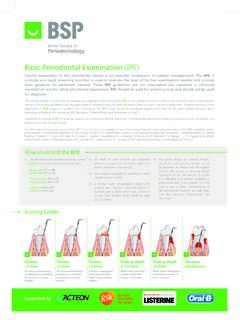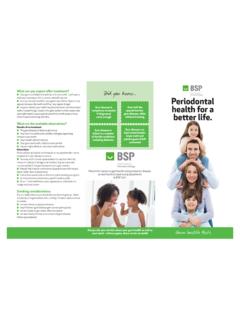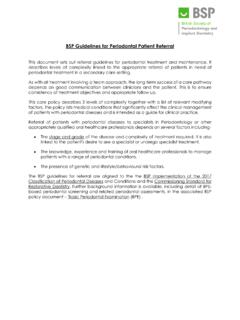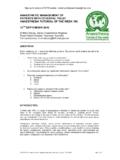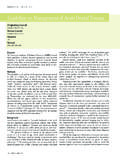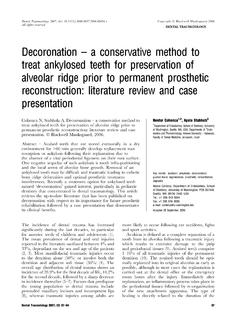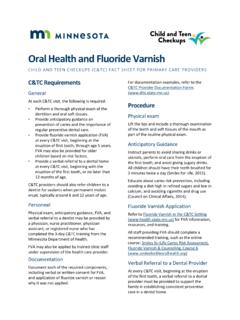Transcription of Assessment and Management of the Periodontal condition …
1 GUIDELINES FOR Periodontal SCREENING AND. Management OF CHILDREN AND ADOLESCENTS UNDER 18. YEARS OF AGE. Guidelines produced in conjunction with the British Society of Periodontology and British Society of Paediatric Dentistry Professor Valerie Clerehugh, Professor of Periodontology, Leeds Dental Institute;. Dr Susan Kindelan, Consultant in Paediatric Dentistry, Beeston Hill Health Centre, Leeds Community Healthcare Trust. Foreword Following the British Society of Periodontology (BSP) Policy Statement in 2001 relating to the screening and Management of Periodontal problems in adults seen in primary dental care, and the update to the BSP's Referral Policy and Parameters of Care' and Basic Periodontal Examination' documents in 2011, the need for similar guidelines pertaining to children and adolescents is recognized.
2 This document sets out the joint recommendations of the BSP and the British Society of Paediatric Dentistry (BSPD) for the Periodontal screening and Management of children and adolescents under the age of 18 years in the primary dental care setting. It can be read alongside the original policy documents for adults from the BSP ( ). Introduction There are many different forms of Periodontal disease which can affect children and adolescents, based on the 1999 International Workshop for a classification of Periodontal diseases and conditions (Armitage, 1999.)
3 Clerehugh et al 2004): Gingival diseases Chronic periodontitis Aggressive periodontitis Periodontitis as a manifestation of systemic diseases Necrotising Periodontal diseases Abscesses of the periodontium Periodontitis associated with endodontic lesions Developmental or acquired deformities and conditions Dental practitioners have an important role to play in the early recognition and diagnosis of gingival and Periodontal diseases. This will ensure the greatest chance for successful treatment either within the primary dental care setting or by referral to appropriate specialist services.
4 Management needs to incorporate effective oral hygiene practices in childhood and adolescence which should extend into early adulthood and beyond. 2012 British Society of Periodontology and The British Society of Paediatric Dentistry 1. The aims of these guidelines are two fold: 1) To outline a method of screening children and adolescents for Periodontal diseases during the routine clinical dental examination in order to detect the presence of gingivitis or periodontitis at the earliest opportunity. 2) To provide guidance on when it is appropriate to treat in practice or refer to specialist services, thus optimizing Periodontal outcomes for children and young adolescents.
5 Features of a healthy periodontium In children with a healthy gingival and Periodontal status the gingival margin is several millimeters coronal to the cemento-enamel junction (CEJ). The gingival sulcus may be deep on a fully erupted tooth. In teenagers with a healthy periodontium the alveolar crest is situated between - mm apical to the CEJ (Hausmann et al., 1991). Gingivitis Plaque induced gingivitis As supragingival plaque is allowed to accumulate an inflammatory cell infiltrate develops in the gingival connective tissue and the attachment of the junctional epithelium is disrupted allowing apical migration of the plaque and an increase in the gingival sulcus depth, forming a false gingival pocket.
6 With severe inflammation gingival swelling may occur, creating an even deeper false gingival pocket. At this stage the most apical extent of the junctional epithelium is still at the CEJ with no Periodontal loss of attachment. This process is completely reversible with effective plaque removal. Although dental plaque is the essential aetiological agent in Periodontal disease, various local and systemic factors (risk factors) can modify the response of the individual to plaque accumulation and influence the development or progression of gingivitis to periodontitis.
7 Plaque-induced gingivitis can occur at any age from early childhood through the teenage years and beyond. Epidemiological studies report a low prevalence of gingivitis during preschool age, followed by a gradual increase in prevalence reaching a peak around puberty, perhaps due to changes in the bacterial composition of the dental plaque, the inflammatory cell response and hormonal changes (Bimstein & Matsson, 1999). The 2003 Child Dental Health Survey (White et al., 2006) involved a representative sample of 5-, 8-, 12- and 15-year-olds in the United Kingdom and in total 10,381 children were examined.
8 It demonstrated higher levels of plaque and gingival inflammation in children age 8 and 12 years than in a younger cohort. Only about one third of 5-year-olds in the epidemiological survey had gingival inflammation, compared to two thirds of 8- and 12- year-old children and half of 15-year-olds. Necrotising Ulcerative Gingivitis Necrotising Periodontal diseases have characteristic features and a fusiform-spirochaetal microbial aetiology. They are more usually found in patients in developing countries who typically exhibit various risk factors, including smoking, immunosuppression, stress, 2012 British Society of Periodontology and The British Society of Paediatric Dentistry 2.
9 Malnourishment and poor diet. They may be associated with HIV positive status or other underlying undiagnosed pathology in an immunosuppressed host: Necrotising Ulcerative Gingivitis (NUG): o pain is a key diagnostic feature o necrosis of the interdental papillae which have a punched out . appearance, ulceration and spontaneous bleeding o secondary foetor oris o pseudomembrane may be present o may manifest in teenagers May progress to Necrotising Ulcerative Periodontitis (NUP). Non-plaque induced gingival lesions Children may also present with non-plaque induced gingival lesions, a number of which are best referred (Table 1).
10 Further details of the more unusual forms are provided elsewhere (Chapple, 2004). Periodontitis The key features of periodontitis are: Loss of attachment of the Periodontal connective tissues to cementum Apical migration of the junctional epithelium (JE) beyond the cemento-enamel junction and transformation of the JE to pocket epithelium (often thin and ulcerated). Alveolar bone loss There are different forms of periodontitis which can affect children and adolescents: Chronic periodontitis Aggressive periodontitis Necrotising ulcerative periodontitis Periodontitis associated with systemic diseases Chronic periodontitis A substantial proportion of adolescents begin to manifest loss of attachment of 1mm or more, consistent with the early stages of chronic periodontitis.
